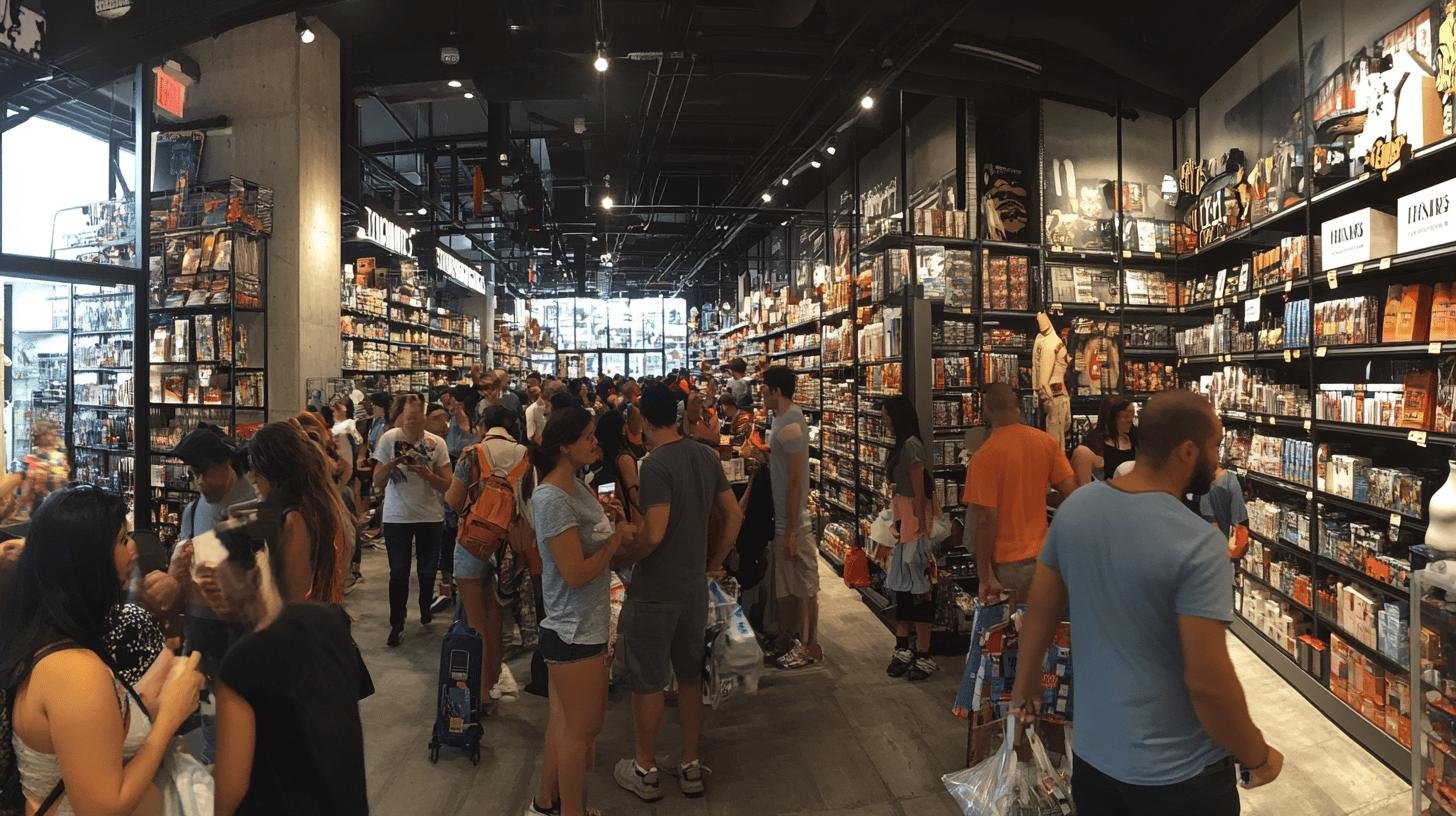TL;DR:
- Retail market analysis helps small businesses find competitive advantages through customer segmentation and understanding market gaps.
- Tools: Crunchbase, Google Trends, SWOT Analysis, Social Media Monitoring.
- A unique value proposition (UVP) differentiates a business; examine unique benefits and use customer feedback.
- Technology (e.g., AI, image recognition) enhances customer experiences and efficiency.
- Customer engagement strategies include personalized promotions, loyalty programs, and in-store events.
- Strategic pricing tactics like dynamic and value-based pricing can attract customers.
- Building partnerships with suppliers strengthens market positions.
- Brand positioning enhances loyalty through personalized communication and exclusive offers.
Ever feel like the retail market is a jungle? It’s filled with competitors, and the battle is fierce. If you’re a small business owner, it may seem like the big guys have the upper hand. But don’t worry—there are strategies you can use to beat the competition in the retail business.
This article covers how to gain an edge by analyzing your market, offering unique value, and leveraging technology. Let’s dive into the details.
Understanding Retail Market Analysis for Competitive Edge
Conducting a detailed retail market analysis helps small businesses find a competitive advantage. By exploring market trends and segmenting customers, you can create strategies that better meet your audience’s needs. This analysis reveals market gaps your business can fill, helping you outperform competitors. Customer segmentation lets you personalize marketing, ensuring your products appeal to various customer groups. It’s also important to understand your competitors. This knowledge helps anticipate their moves and find areas where you can differentiate.
- Crunchbase: Discover competitors’ funding and industry presence.
- Store Locators: Check brand and product availability by location.
- Google Trends: Analyze search trends to gauge interest.
- Social Media Monitoring Tools: Track competitors’ engagement and feedback.
- SWOT Analysis: Identify strengths, weaknesses, opportunities, and threats.
Using these insights, small businesses can find a niche, setting them apart from larger corporations. They can focus on unique selling points and understand customer needs better than competitors. This leads to stronger customer relationships and increased market share, contributing to sustainable growth.
Crafting a Unique Value Proposition to Stand Out

A unique value proposition (UVP) is vital for any retail business looking to stand out in a crowded market. It clearly communicates why customers should choose your business over others. A strong UVP makes your brand memorable. To develop your UVP, examine your products and services. Consider what unique benefits they provide. Use the Stanford Question Answering Dataset (SQuAD) method to explore specifics: “What problem does my product solve that competitors don’t?” Focus on effectiveness or convenience as your solution. Use customer feedback and market trends to highlight features the competition lacks.
Creative marketing and a welcoming store environment can enhance your UVP presentation. Think about how store layout, design, and customer interactions can reinforce your proposition. A strong brand identity coupled with a great customer experience can boost loyalty and market differentiation. A consistent brand experience—through personalized service, loyalty programs, or exclusive offers—gives customers reasons to return. This strategy not only retains current customers but also attracts new ones who appreciate high-quality experiences over price competition.
Leveraging Technology and Digital Innovation in Retail
Technology plays a crucial role in gaining an edge in today’s retail environment. Using advancements like artificial intelligence (AI) can enhance customer experiences. For example, AI-powered chatbots provide 24/7 support, addressing questions and making recommendations. Image recognition technology is also transformative. It improves product placement and inventory management. Understanding customer interactions and preferences allows retailers to tailor offers and boost efficiency. Digital tools like virtual try-ons and augmented reality enrich shopping experiences, making them more interactive.
To integrate these tech solutions, start with a strategic approach. Small retailers should identify areas where technology addresses specific challenges. Begin with a needs assessment to align technologies with business goals. If customer service is a priority, invest in AI or CRM systems. Focus on training staff to effectively use selected tools and collaborate with tech providers for seamless implementation and support. Testing technologies on a smaller scale helps assess impact before full rollout, reducing risks and maximizing returns.
| Technology | Benefit | Cost |
| AI Chatbots | 24/7 Customer Support | Moderate |
| Image Recognition | Better Product Placement | High |
| CRM Systems | Improved Customer Management | Low to Moderate |
By adopting these innovations, small retailers can streamline operations and improve the customer experience, positioning themselves favorably against larger competitors.
Effective Customer Engagement Techniques

Customer engagement is essential for a successful retail business. Why is it important? It builds a loyal customer base that returns to your brand. This loyalty means steady revenue and growth. Personalization plays a key role. This means tailoring experiences and offers to individual preferences. When customers feel appreciated and understood, they’re more likely to come back. Engaging customers means going beyond transactions to create memorable experiences that resonate personally. Such experiences encourage word-of-mouth promotion and brand loyalty, which are crucial for standing out.
- Personalized Promotions: Tailor discounts based on past purchases.
- Social Media Interaction: Engage with customers on platforms like Instagram and Facebook.
- Loyalty Programs: Create reward systems to encourage repeat purchases.
- In-Store Events: Host exclusive events to foster community and brand interaction.
- Feedback Channels: Collect and act on feedback to improve service.
These strategies boost customer loyalty and repeat business. Personalized promotions and loyalty programs offer exclusivity, making customers feel valued. Social media interactions provide direct engagement, fostering connection and community. Hosting in-store events strengthens this bond through unique experiences. By using these techniques, small retailers can build strong customer relationships, ensuring they return, thus creating a competitive edge over larger rivals.
Strategic Pricing Tactics in Retail
Pricing is a powerful tool to influence consumer behavior. It can attract or deter customers. A good pricing strategy not only draws in customers but also encourages purchases. For small retailers, competitive pricing enhances shelf presence and captures market share. Strategic pricing makes your brand stand out. Even higher prices can work when the value justifies them.
- Dynamic Pricing: Adjust prices based on demand or competition.
- Value-Based Pricing: Set prices according to perceived product value.
- Psychological Pricing: Use strategies like $9.99 to make prices seem lower.
- Bundle Pricing: Offer product bundles at reduced rates to increase sales.
These tactics help small retailers carve out a niche, differentiating from larger competitors. Dynamic and value-based pricing allows flexibility and responsiveness to market changes. Psychological and bundle pricing create a sense of value and urgency. By emphasizing their unique value propositions, small retailers can justify higher prices, offering value while remaining competitive.
Building Strong Retail Partnerships and Alliances

Forming strategic partnerships with suppliers and partners is key for small retail businesses seeking a competitive edge. Why are these partnerships important? They lead to better deals, exclusive products, and market advantages. Strong supplier relationships allow for favorable terms and access to products competitors might not get, which can set your store apart and draw customers.
Successful partnership examples show how collaboration boosts resilience against bigger competitors. For instance, a bookstore partnering with local authors for signings attracts loyal customers and enhances its community reputation. Similarly, a boutique working with local artisans for exclusive items builds unique selling points and support networks. Collaborations can elevate the category and lead to mutual benefits, sometimes even partnering with competitors to expand the market. This strengthens small retailers’ market positions, enabling them to thrive despite the presence of larger corporations.
Enhancing Brand Positioning and Loyalty
Brand positioning is essential for ensuring customers return. How does it help? It defines your business’s unique market position, making it memorable. A strong brand identity attracts and retains customers. It’s not just about pricing; focus on what makes your business unique—be it exceptional service, exclusive products, or a distinct atmosphere. Delivering a consistent brand experience builds trust and recognition, translating to repeat business. Customers who connect with your brand are less likely to switch, even for lower prices.
- Membership Rewards: Loyalty programs with points for purchases earn discounts or freebies.
- Personalized Communication: Use data to send tailored messages and offers.
- Gift Cards: Encourage repeat purchases with redeemable gift cards.
- Exclusive Offers: Provide early access or special deals to make loyal customers feel valued.
These strategies help small businesses stand out against larger competitors by fostering deeper audience connections. By focusing on brand positioning and loyalty, small retailers can create supportive communities around their brands. This boosts customer retention and attracts new customers who value distinctive shopping experiences.
Final Words
Beating the competition in retail business is tough but possible with the right strategies. By conducting a retail market analysis, offering a unique value proposition, and leveraging technology, you can create a competitive edge. Engaging customers, using smart pricing, and forming partnerships will further solidify your position in the market.
Remember, it’s not just about being the cheapest—it’s about creating a brand that customers love and want to return to. With these strategies, you can outsmart the competition and thrive in today’s retail landscape.
FAQ
How can I beat competition in retail business today?
Focus on customer engagement, unique value propositions, and leveraging technology like AI. Use pricing strategies and partnerships to stay competitive.
What are competitive retail strategies?
Competitive strategies include dynamic pricing, personalized customer service, and adopting new technologies like chatbots or CRM systems.
How do I stand out in retail business?
Develop a unique value proposition and focus on excellent customer experiences. Engage customers through personalized offers and social media.
What is dynamic pricing?
Dynamic pricing adjusts prices based on demand, competitor prices, or other factors, allowing retailers to stay competitive.
What types of businesses generally prefer freestanding locations?
A: Businesses like big-box stores, standalone restaurants, and specialty retailers prefer freestanding locations. This choice allows for greater brand visibility, more control over store design, and ample parking for customers.

